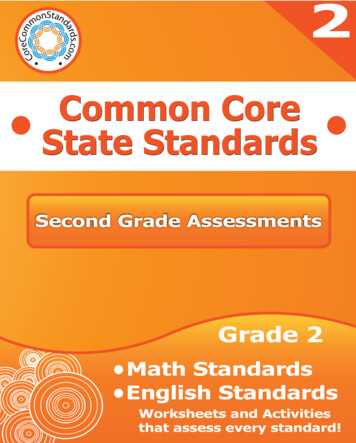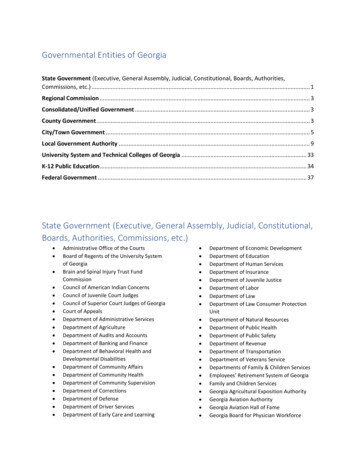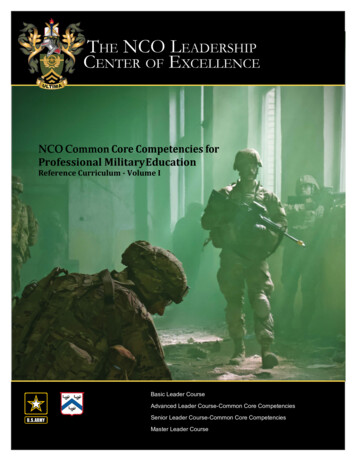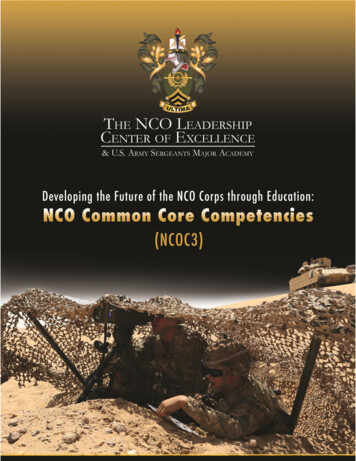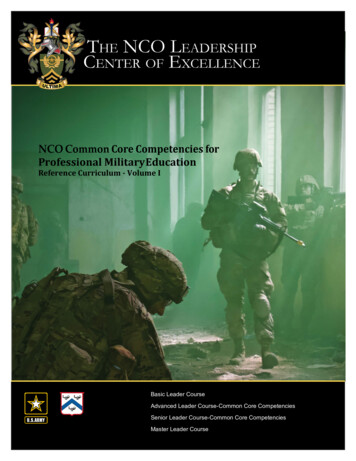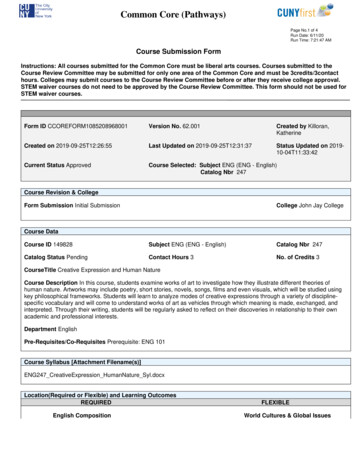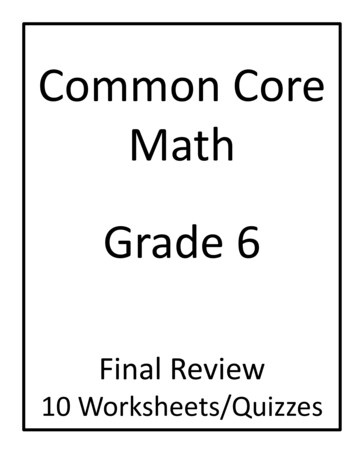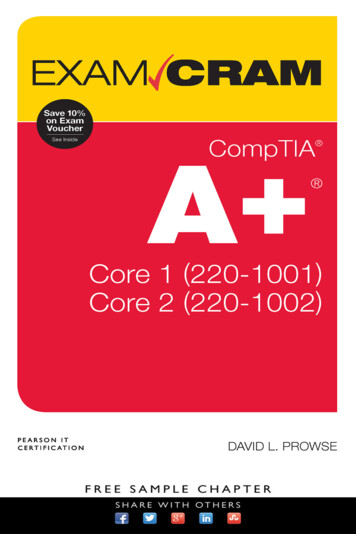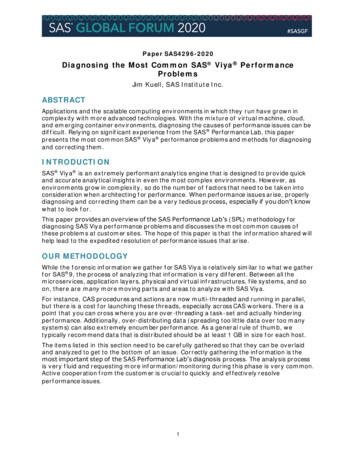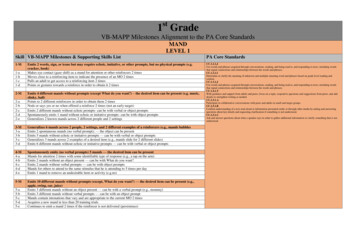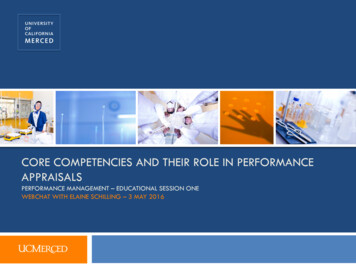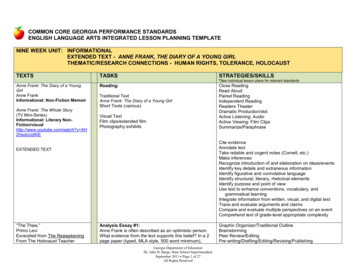
Transcription
COMMON CORE GEORGIA PERFORMANCE STANDARDSENGLISH LANGUAGE ARTS INTEGRATED LESSON PLANNING TEMPLATENINE WEEK UNIT: INFORMATIONALEXTENDED TEXT - ANNE FRANK, THE DIARY OF A YOUNG GIRLTHEMATIC/RESEARCH CONNECTIONS - HUMAN RIGHTS, TOLERANCE, HOLOCAUSTTEXTSTASKSAnne Frank: The Diary of a YoungGirlAnne FrankInformational: Non-Fiction MemoirReading:STRATEGIES/SKILLS*See individual lesson plans for relevant standardsAnne Frank: The Whole Story(TV Mini-Series)Informational: Literary NonFiction/visualhttp://www.youtube.com/watch?v XH2HxdnUdWETraditional TextAnne Frank: The Diary of a Young GirlShort Texts (various)Visual TextFilm clips/extended filmPhotography exhibitsCite evidenceAnnotate textTake reliable and cogent notes (Cornell, etc.)Make inferencesRecognize introduction of and elaboration on ideas/eventsIdentify key details and extraneous informationIdentify figurative and connotative languageIdentify structural, literary, rhetorical elementsIdentify purpose and point of viewUse text to enhance conventions, vocabulary, andgrammatical learningIntegrate information from written, visual, and digital textTrace and evaluate arguments and claimsCompare and evaluate multiple perspectives on an eventComprehend text of grade-level appropriate complexityEXTENDED TEXT“The Thaw,”Primo LeviExcerpted from The ReawakeningFrom The Holocaust TeacherClose ReadingRead AloudPaired ReadingIndependent ReadingReaders TheaterDramatic Production/skitActive Listening: AudioActive Viewing: Film ClipsSummarize/ParaphraseAnalysis Essay #1:Anne Frank is often described as an optimistic person.What evidence from the text supports this belief? In a 2page paper (typed, MLA style, 500 word minimum),Georgia Department of EducationDr. John D. Barge, State School SuperintendentSeptember 2011 Page 1 of 27All Rights ReservedGraphic Organizer/Traditional OutlineBrainstormingPeer g/Publishing
Resource CenterInformational: aw.htmSHORT TEXTLiterary discussion: “The Thaw”Structure, imagery, context,purpose, point of htmInformational: Academicdiscuss Anne's word choice, syntax, imagery and anyother pertinent rhetorical elements that help create hervoice and tone in the diary.Analysis Essay #2:Anne Frank's famous quote, "In spite of everything, I stillbelieve that people are really good at heart," is borne outby some of the people portrayed in the diary anddisproved by others. Choose one individual from thediary and use evidence from the text to show how theyprove or disprove Anne's maxim (2 pages typed, MLAstyle, 500 word minimum).SHORT TEXTAnne Frank: Beyond the Diary - APhotographic RemembranceRuud van der Rol and RianVerhoevenInformational: Visual Text(photographs)SHORT TEXT (VISUAL)Research Paper:Is human character shaped by "nature" (e.g., genes,nutrition, and inherent skill) or by "nurture" (e.g.,upbringing, cultural values, good or bad habits).Research the latest scientific findings and philosophicaldebate on this issue and write a 3 page paper in APAformat presenting your research. Use appropriatecitations.Shamash: Holocaust /photos/Informational: Visual TextWriter’s WorkshopCo-ConstructionRubric Study (e.g., diction, organization, fluency)Student ModelsSupport claims with clear and relevant textual evidenceEvaluate sources for credibilityUse effective transitions and provide a concluding statementConvey ideas/concepts/information through selection,organization, and analysis of relevant contentAdequately develop topicEmploy effective literary and rhetorical techniquesEngage and orient readerEmploy all steps of writing processUse technology effectivelyUse information from a variety of sourcesUse writing assignment to enhance conventions,vocabulary, and grammatical learningGraphic OrganizerTraditional OutlineBrainstormingDebatePeer g/PublishingCo-ConstructionRubric Study (e.g., diction, organization, fluency)Student ModelsConvey ideas/concepts/information through selection,organization, and analysis of relevant contentEmploy relevant facts, definitions, details, quotations, andquantitative data including graphical dataUse precise language and domain specific vocabularyEmploy clear transitionsEmploy formal style (including specified manuscript stylesuch as APA or MLA when required)Provide conclusion that follows from the informationpresentedEmploy all steps of writing processUse technology effectivelyUse information from a variety of sourcesUse primary and secondary sources as appropriateSHORT TEXT (VISUAL)“The Scream”Edward MunchOil on CanvasLiterary: Visual TextSHORT TEXT (VISUAL)Georgia Department of EducationDr. John D. Barge, State School SuperintendentSeptember 2011 Page 2 of 27All Rights Reserved
Employ effective text structures (e.g., comparison, causality)Use writing assignment to enhance conventions,vocabulary, and grammatical learningRoutine Writing:Example One: Keep your own diary daily for two weeks;examining your text, do you find yourself to be anoptimistic person or a pessimistic person?Example Two: Look at the newspaper clippings providedto the class this morning. What human rights issues canyou identify in our own country or community? Write aletter to the editor expressing your opinion on this issueand/or suggesting a course of action.Example Three: Write a single diary entry for Annedescribing an imaginary day that, unfortunately, neveractually took place. Describe the successfulrescue/liberation of the people in Anne's hiding place.How does the rescue come about? What are the historicand personal circumstances (be accurate). How doeseveryone feel/react?Co-ConstructionStudent ModelsShadow/Echo Writing (emulate an example text)Multi-Modal Prompts (response to article, photograph, etc.)Purpose/Genre explorationEngage and orient readerEmploy genre appropriate style and formatUse routine writing as a forum for free expression andcreativityEmploy appropriate and effective text structuresEstablish voice and styleDraw evidence from or establish relation to relevant textwhen appropriateRoutine writing should always demonstrate an awarenessof texts and themes under discussion within the UnitUse writing assignment to enhance conventions,vocabulary, and grammatical learningShadow Poetry: Write a poem based on the structure ofthe “They Came For” poem, expressing your own uniqueviewpoint or experience.The Freedom Writers Diary : How aTeacher and 150 Teens UsedWriting to Change Themselves andthe World Around Them (Excerpts)The Freedom WritersInformational: MemoirSHORT TEXTNarrative Writing:What Anne Frank experienced was an extreme version ofthe kinds of intolerance, bullying, and bigotry that peoplestill experience every day. Write a personal narrativedescribing a time you were a victim of this type ofbehavior, or a time when you treated someone elseunfairly. Be sure to let your own unique voice comethrough in your writing, using tense, voice, imagery, andall the other literary tools at your disposal to engage youraudience.Graphic OrganizerTraditional OutlineBrainstormingPeer g/PublishingWriter’s WorkshopCo-ConstructionRubric Study (e.g., diction, organization, fluency)Student ModelsEmploy effective literary and rhetorical techniques includingdiction, syntax, tone, imagery, and figurative languageEffectively structure plot and develop characters usingstrategies such as dialogue and pacingGeorgia Department of EducationDr. John D. Barge, State School SuperintendentSeptember 2011 Page 3 of 27All Rights Reserved
Use effective transitions and provide a concluding statementConvey ideas/concepts/information through selection,organization, and analysis of relevant contentUse effective transitions to convey sequence and shiftsProvide conclusion that follows from narrated experiencesAdequately develop topicEngage and orient readerEmploy all steps of writing processUse technology effectivelyUse writing assignment to enhance conventions,vocabulary, and grammatical learningZlata’s Diary: A Child’s Life inSarajevo (Excerpts)Zlata FilipovicInformational: MemoirSHORT TEXTPictures of LoveClose study of visual images from short texts. Studentscompose photographs, film, or sculpture on a theme oftolerance and peace. Students will use evidence from thetext to support and provide analysis for their graphic.Field Trip (formal or simply moving about the building)BrainstormStudent ModelsShadow/Echo visuals (emulate an example visual)Rubric StudyPractice/Training in artistic media/digital media as neededCompare and contrast viewing experiences to textexperiencesEffective use of digital and artistic mediaEngage in effective collaborative discussionDemonstrate understanding of multiple perspectivesUse assignment to enhance conventions, vocabulary, andgrammatical learningSupport claims with clear and relevant textual evidenceAnneFrank.ComThis definitive site focuses on AnneFrank and her world-famous diary. Itcontains excerpts from her diary, aphoto scrapbook of her life, andinformation about a travelingmuseum exhibit about her.http://www.annefrank.comInformational: DigitalMock Trial of Ann Frank’s InformantStudents use text-based evidence and additionalresearch to indict and conduct a mock courtroom trial ofthe person or persons they believe betrayed the familiesto the Nazi authorities.Collaborative DiscussionField Trip (courthouse)Guest SpeakerDebateActive Viewing: Film (Nuremburg Trials)Internet and Library ResearchBrainstormingPair/ShareRubric StudySHORT TEXTSEngage effectively in group collaborationEvaluate a speaker’s argument and claimsDistinguish claims that are supported by evidence fromGeorgia Department of EducationDr. John D. Barge, State School SuperintendentSeptember 2011 Page 4 of 27All Rights Reserved
those that are notPresent claims and findings logicallyChoose pertinent and relevant factsRecognize and exclude extraneous detailsSupport claims with clear and relevant textual evidenceEvaluate sources for credibilityUse effective concluding statements where appropriateConvey ideas/concepts/information through selection,organization, and analysis of relevant contentEmploy effective rhetorical techniquesInclude multimedia components to strengthen case ortestimony where appropriateRecognize variations in dialect and language choices(in this case, based on character background)Use appropriate domain-specific vocabulary (for examplecourtroom/legal vocabulary)Use assignment to enhance conventions, vocabulary, andgrammatical learning“First They Came ”Martin NiemollerLiterary: PoemSHORT TEXTNo Hate Zone CampaignStudents study human rights issues in their ownenvironment and use various forms of persuasive media(e.g., public service announcement, brochure, printadvertisement, billboard, t-shirts) to promote goodwill andtolerance.“Tolerance”Egal rary: PoemGuest Speaker (public relations/advertising)Active Viewing: PSAsInterview/DebateInternet and Library ResearchCollaborative DiscussionBrainstormingPractice/Training in artistic media/digital media as neededRubric StudyAnnotationCitationWebsite vettingEngage effectively in group collaborationIntegrate information from written, visual, and digital textTrace and evaluate arguments and claimsCompare and evaluate multiple perspectives on an eventConvey ideas/concepts/information through selection,organization, and analysis of relevant contentEmploy effective rhetorical techniquesPresent claims and findings logicallyUse multi-media componentsAdapt speech to a variety of contexts and tasksUse assignment to enhance conventions, vocabulary, andSHORT TEXTGeorgia Department of EducationDr. John D. Barge, State School SuperintendentSeptember 2011 Page 5 of 27All Rights Reserved
grammatical learningGeorgia Department of EducationDr. John D. Barge, State School SuperintendentSeptember 2011 Page 6 of 27All Rights Reserved
CalendarWeek One:1Lesson One23Anne Frank: Diary of a Young Girl (1-100*)Anne Frank: The Whole Story (Parts 1-2)Lesson TwoRI: Close reading, annotation, active viewing,inference, textual evidenceL: Vocabulary from Text - Anne’s dictionSyntax - Anne’s sentence structureparts of speech, phrase/clause, compound,complex, how style creates tone, shows ageSL: Collaborative discussion, Socratic SeminarDramatic reading, skits, pair readingW: Routine WritingEngage and orient readerEmploy genre appropriate style and formatUse routine writing as a forum for freeexpression and creativityPictures of LoveClose study of visual images from short texts.Students compose photographs, film, or sculptureon a theme of tolerance and peace.“Tolerance”Egal rary: PoemAnne Frank: Beyond the Diary - A PhotographicRemembranceRuud van der Rol and Rian VerhoevenInformational: Visual TextDifferentiation: Content Interest ReadinessRI: Identify figurative and connotative languageIdentify structural, literary, rhetorical elementsIdentify purpose and point of viewL: Figurative language and word relationshipsSL: Demonstrate understanding of multipleperspectives; presentationW: Mini-argument - rationale for graphicSupport claims with clear and relevant textualevidenceConvey ideas/concepts/information throughselection, organization, and analysis of relevantcontent ProcessAssessment (include Rubric if appropriate):*All recommendations for number of pages ofassigned reading for a particular lesson areapproximate. You may want to spread the readingover several weeks or do it in concentration.Reading more or fewer pages in a given lesson willnot impact your ability to navigate throughsubsequent lessons.Differentiation: Content Interest Readiness ProcessAssessment (include Rubric if appropriate):Georgia Department of EducationDr. John D. Barge, State School SuperintendentSeptember 2011 Page 7 of 27All Rights Reserved
45Notes:Content Assessment for Reading - informalPrepare Rubric for Pictures of LovePresentation for Pictures of Love (gallery?)Week Two:123Lesson ThreeLesson FourAnne Frank: Diary of a Young Girl (101-150)Anne Frank: The Whole Story (Part 3)Freedom WritersAnalysis Essay #1RI: Close reading, independent/paired readingcite evidence, active viewingMake inferencesRecognize introduction of and elaboration onideas/eventsRI: Reader’s Theater, active listening audio bookMake inferencesRecognize introduction of and elaboration onideas/eventsIdentify key details and extraneous informationIdentify figurative and connotative languageIdentify structural, literary, rhetorical elementsIdentify purpose and point of viewL: Commas and parenthetical elementsSL: Collaborative discussion drawing on explicitevidence from text; interpret presentation indiverse format (text vs. film)L: Vague pronouns/ambiguous antecedents (text)Compound/complex sentence structure, phrase,clause, parenthetical elements (writing)W: Routine WritingDemonstrate an awareness of texts and themesunder discussion within the UnitUse writing assignment to enhance conventions,vocabulary, and grammatical learningDifferentiation: Content Interest ReadinessSL: Interpret information presented in diversemedia and formats explaining how it contributeto the topicW: Analysis Essay #1Support claims with clear and relevant textualevidenceEvaluate sources for credibilityUse effective transitions and provide aconcluding statementConvey ideas/concepts/information throughselection, organization, and analysis of relevantcontent ProcessAssessment (include Rubric if appropriate):Differentiation: Content Interest ReadinessGeorgia Department of EducationDr. John D. Barge, State School SuperintendentSeptember 2011 Page 8 of 27All Rights Reserved Process
Assessment (include Rubric if appropriate):45Notes:MLA style, formatting requirementsWeek Three:123Lesson FiveAnne Frank: Diary of a Young Girl (151-250)Anne Frank: The Whole Story (Part 4,5)RI: Independent reading, summary and paraphraseDramatic interpretation (skit)Compare and evaluate multiple perspectives onan eventAnnotate textTake reliable and cogent notes (Cornell, etc.)L: Academic vocabulary, text vocabularySL: Dramatic interpretation (skit)W: Routine WritingUse routine writing as a forum for freeexpression and creativityEmploy appropriate and effective text structuresEstablish voice and styleDifferentiation: Content Interest Readiness ProcessAssessment (include Rubric if appropriate):45Notes:Lesson Six“First They Came ”Martin NiemollerLiterary: PoemShamash: Holocaust Photography ormational: Visual Text“The Scream” Oil on CanvasEdward MunchField Trip/SpeakerRI: Identify figurative and connotative languageIdentify structural, literary, rhetorical elementsIdentify purpose and point of viewIntegrate information from written, visual, anddigital textL: Demonstrate understanding of figurativelanguage, word relationships, and nuances inword meanings.Georgia Department of EducationDr. John D. Barge, State School SuperintendentSeptember 2011 Page 9 of 27All Rights Reserved
Literary: Visual TextDifferentiation: Content Interest ReadinessSL: Dramatic interpretation of poem; adaptingSpeech to context and task ProcessW: Echo Poem, Routine WritingEmploy genre appropriate style and formatUse routine writing as a forum for freeexpression and creativityEmploy appropriate and effective text structuresEstablish voice and styleAssessment (include Rubric if appropriate):Week Four:123Lesson SevenAnne Frank: Diary of a Young Girl (251-336 end)Anne Frank: The Whole Story (Part 6, end)RI: Independent reading, summary and paraphraseDramatic interpretation (skit)Compare and evaluate multiple perspectives onan eventAnnotate textTake reliable and cogent notes (Cornell, etc.)L: Academic vocabulary, text vocabularySL: Dramatic interpretation (skit)W: Routine WritingEmploy appropriate and effective text structuresEstablish voice and styleDraw evidence from or establish relation torelevant text when appropriateDifferentiation: Content Interest Readiness ProcessAssessment (include Rubric if appropriate):45Lesson EightAnalysis Essay #2RI: Cite evidence, determine central ideaAnalyze in detail how key individuals, eventsand ideas are introduced and elaboratedDetermine author’s point of view and purposeGeorgia Department of EducationDr. John D. Barge, State School SuperintendentSeptember 2011 Page 10 of 27All Rights ReservedAdequately develop topicEmploy effective literary and rhetoricaltechniquesEngage and orient reader
L:SL: Collaborative discussion, peer reviewW: Support claims with clear and relevant textualevidenceEvaluate sources for credibilityUse effective transitions and provide aconcluding statementConvey ideas/concepts/information throughselection, organization, and analysis of relevantcontentWeek Five:1Employ all steps of writing processUse technology effectivelyUse information from a variety of sourcesCommas and parenthetical elements, sentenceStructure, pronoun antecedents2Differentiation: Content Interest ReadinessAssessment (include Rubric if appropriate):Notes:Cinema Day, popcornLibrary research day3Lesson EightAnalysis Essay #2, continuedConvey ideas/concepts/information throughselection, organization, and analysis of relevantcontentAdequately develop topicEmploy effective literary and rhetoricaltechniquesEngage and orient readerEmploy all steps of writing processUse technology effectivelyUse information from a variety of sourcesRI: Cite evidence, determine central ideaAnalyze in detail how key individuals, eventsand ideas are introduced and elaboratedDetermine author’s point of view and purposeL:Commas and parenthetical elements, sentenceStructure, pronoun antecedentsSL: Collaborative discussion, peer reviewW: Support claims with clear and relevant textualevidenceEvaluate sources for credibilityUse effective transitions and provide aconcluding statement4Differentiation: Content Interest Readiness ProcessAssessment (include Rubric if appropriate):5Notes:Lesson NineGeorgia Department of EducationDr. John D. Barge, State School SuperintendentSeptember 2011 Page 11 of 27All Rights Reserved Process
“The Thaw,”Primo LeviExcerpted from The mLiterary discussion: “The Thaw”Structure, imagery, context, purpose, point of .htmRI: Close ReadingRead AloudSummarize/paraphraseInferenceL:Sentence structure, vocabulary studySL: Delineate a speaker’s argument and claimsPose and respond to specific questions indiscussionCome to discussion preparedPrimo Levi story, audio tapesFlip chart for SmartboardW: Routine Writing,Engage and orient readerEmploy genre appropriate style and formatUse routine writing as a forum for freeexpression and creativityDifferentiation: Content Interest Readiness ProcessAssessment (include Rubric if appropriate):Week Six:123Lesson Nine, continuedLesson Ten“The Thaw,”Primo LeviExcerpted from The mZlata’s Diary: A Child’s Life in Sarajevo(Excerpts)Zlata FilipovicChildren of War/WebquestLiterary discussion: “The Thaw”Structure, imagery, context, purpose, point of .htmRI: Identify structural, literary, rhetorical elementsIdentify purpose and point of viewIntegrate information from written, visual, anddigital textTrace and evaluate arguments and claimsCompare and evaluate multiple perspectives onan eventRI: Close ReadingRead AloudSummarize/paraphraseInferenceL:L:Sentence structure, vocabulary studyVocabulary strategies/thesaurus and dictionarySL: Collaborative discussion with preparationReview key ideas, demonstrate understandingSL: Delineate a speaker’s argument and claimsPose and respond to specific questions inW: Routine WritingGeorgia Department of EducationDr. John D. Barge, State School SuperintendentSeptember 2011 Page 12 of 27All Rights Reserved
discussionCome to discussion preparedDraw evidence from or establish relation torelevant text when appropriateDemonstrate an awareness of texts and themesunder discussion within the UnitW: Routine Writing,Engage and orient readerEmploy genre appropriate style and formatUse routine writing as a forum for freeexpression and creativityDifferentiation: Content Interest ReadinessDifferentiation: Content Interest ReadinessAssessment (include Rubric if appropriate): ProcessAssessment (include Rubric if appropriate):45Notes:Computer labMeet with media specialistWeek Seven:1Lesson ElevenMock TrialRI: Cite evidenceAnnotate textTake reliable and cogent notes (Cornell, etc.)Make inferencesRecognize introduction of and elaboration onideas/eventsIdentify key details and extraneous informationIdentify figurative and connotative languageIdentify structural, literary, rhetorical elementsIdentify purpose and point of viewUse text to enhance conventions, vocabulary,and grammatical learningIntegrate information from written, visual, and Process23SL: Collaborative DiscussionDebateEngage effectively in group collaborationEvaluate a speaker’s argument and claimsDistinguish claims that are supported byevidence from those that are notPresent claims and findings logicallyInclude multimedia components to strengthencase or testimony where appropriateW: Choose pertinent and relevant factsRecognize and exclude extraneous detailsSupport claims with clear and relevant textualevidenceEvaluate sources for credibilityGeorgia Department of EducationDr. John D. Barge, State School SuperintendentSeptember 2011 Page 13 of 27All Rights Reserved
digital textTrace and evaluate arguments and claimsCompare and evaluate multiple perspectiveson an eventL:Use appropriate domain-specific vocabulary(for example courtroom/legal vocabulary)Use effective concluding statements whereappropriateConvey ideas/concepts/information throughselection,organization, and analysis of relevant contentDifferentiation: Content Interest Readiness ProcessAssessment (include Rubric if appropriate):45Notes:AV EquipmentReserve presentation roomWeek Eight:1235Notes:Lesson Eleven, continuedMock Trial4Lesson TwelveResearch Project: Nature vs. NurtureRI: Cite evidenceAnnotate textTake reliable and cogent notes (Cornell, etc.)Make inferencesIdentify key details and extraneous informationReserve Library/Computer LabEmploy all steps of writing processUse technology effectivelyUse information from a variety of sourcesUse primary and secondary sources asappropriateEmploy effective text structures (e.g.,Georgia Department of EducationDr. John D. Barge, State School SuperintendentSeptember 2011 Page 14 of 27All Rights Reserved
L: Commas and parenthetical elementsCompound/complex sentence structure, phrase/clauseRecognize and correct vague pronounsEnsure proper case pronounsSL: Convey ideas/concepts/information throughselection, organization, and analysis of relevantcontentcomparison, causality)Use writing assignment to enhance conventions,vocabulary, and grammatical learningDifferentiation: Content Interest Readiness ProcessAssessment (include Rubric if appropriate):W: Employ relevant facts, definitions, details,quotations, and quantitative data includinggraphical dataUse precise language and domain specificvocabularyEmploy clear transitionsEmploy formal style (including specifiedmanuscript style such as APA or MLA whenrequired)Provide conclusion that follows from theinformationpresentedWeek Nine:123Lesson Twelve, continuedResearch ProjectLesson ThirteenNo Hate CampaignRI: Cite evidenceAnnotate textTake reliable and cogent notes (Cornell, etc.)Make inferencesGeorgia Department of EducationDr. John D. Barge, State School SuperintendentSeptember 2011 Page 15 of 27All Rights ReservedTrace and evaluate arguments and claimsCompare and evaluate multiple perspectiveson an eventEmploy effective rhetorical techniquesPresent claims and findings logicallyUse multi-media components
Recognize introduction of and elaboration onideas/eventsIdentify key details and extraneous informationL:Demonstrate command of the conventions ofstandard EnglishSL: Collaborative DiscussionBrainstormingEngage effectively in group collaborationIntegrate information from written, visual, anddigital textAdapt speech to a variety of contexts and tasksW: Employ effective rhetorical techniquesPresent claims and findings logicallyUse multi-media componentsConvey ideas/concepts/information throughselection, organization, and analysis of relevantcontentDifferentiation: Content Interest Readiness ProcessAssessment (include Rubric if appropriate):45Notes:No Place for HateCampaign activitiesSchool buy-inGeorgia Department of EducationDr. John D. Barge, State School SuperintendentSeptember 2011 Page 16 of 27All Rights Reserved
COMMON CORE GEORGIA PERFORMANCE STANDARDSENGLISH LANGUAGE ARTS INTEGRATED LESSON PLANNING TEMPLATENINE WEEK UNIT: INFORMATIONALEXTENDED TEXT - ANNE FRANK, THE DIARY OF A YOUNG GIRLTHEMATIC/RESEARCH CONNECTIONS - HUMAN RIGHTS, TOLERANCE, HOLOCAUSTLesson 11Task: Mock TrialAs the unit reaches its last few weeks, students will revisit the original extended text for a close analysis of character (in this case actual individuals), narrative, andsetting. Although there has been a great deal of speculation over the years, it has never been discovered who turned in the Frank family to the Nazi authorities.Students will consider evidence from the text and will conduct research from other reliable sources in order to form a supportable accusation (indictment). Studentswill adopt roles: prosecuting and defending attorney(s), jurors, judge, witnesses, accused, and court reporter. As the mock trial progresses, judge and jurors willuse their content knowledge about logical fallacies, supportable claims, what constitutes reliable evidence, what is extraneous detail, and the facts from the textand from history to reach a verdict. All evidence used in the trial must be cited, whether formally or informally.Essential Question for Lesson 11How much evidence and what kind of evidence must accrue before we assume a thing to be true?TaskSkillStandardRevisit the textGroup discussionCollaborative discussionBrainstormClose readingAnnotationELACC6SL1: Engage effectively in a range of collaborative discussions (one-on-one,in groups, and teacher-led) with diverse partners on grade 6 topics, texts, and issues,building on others’ ideas and expressing their own clearly.ELACC6RI2: Determine a central idea of a text and how it is conveyed throughparticular details; provide a summary of the text distinct from personal opinions orjudgments.ELACC6RI8: Trace and evaluate the argument and specific claims in a text,distinguishing claims that are supported by reasons and evidence from claims that arenot.6T2a. Interact, collaborate, and publish with peers, experts, or others employing avariety of digital environments and media.Break into small groupsConduct preliminary researchWork effectively in studentcentered activitiesWork effectively in collaborationwith othersUnderstand multiple perspectivesIntroduce claims with clearlyELACC6RI1: Cite textual evidence to support analysis of what the text says explicitlyas well as inferences drawn from the text.ELACC6W7: Conduct short research projects to answer a question, drawing onseveral sources and refocusing the inquiry when appropriate.ELACC6W8: Gather relevant information from multiple print and digital sources;assess the credibility of each source; and quote or paraphrase the data andGeorgia Department of EducationDr. John D. Barge, State School SuperintendentSeptember 2011 Page 17 of 27All Rights Reserved
organized and relevant evidenceconclusions of others while avoiding plagiarism and providing basic bibliographicinformation for sources.ELACC6W9: Draw evidence from litera
Anne Frank: Diary of a Young Girl (1-100*) Anne Frank: The Whole Story (Parts 1-2) RI: Close reading, annotation, active viewing, inference, textual evidence L: Vocabulary from Text - Anne’s diction Syntax - Anne’s sentence structure parts of speech, phrase/cla
